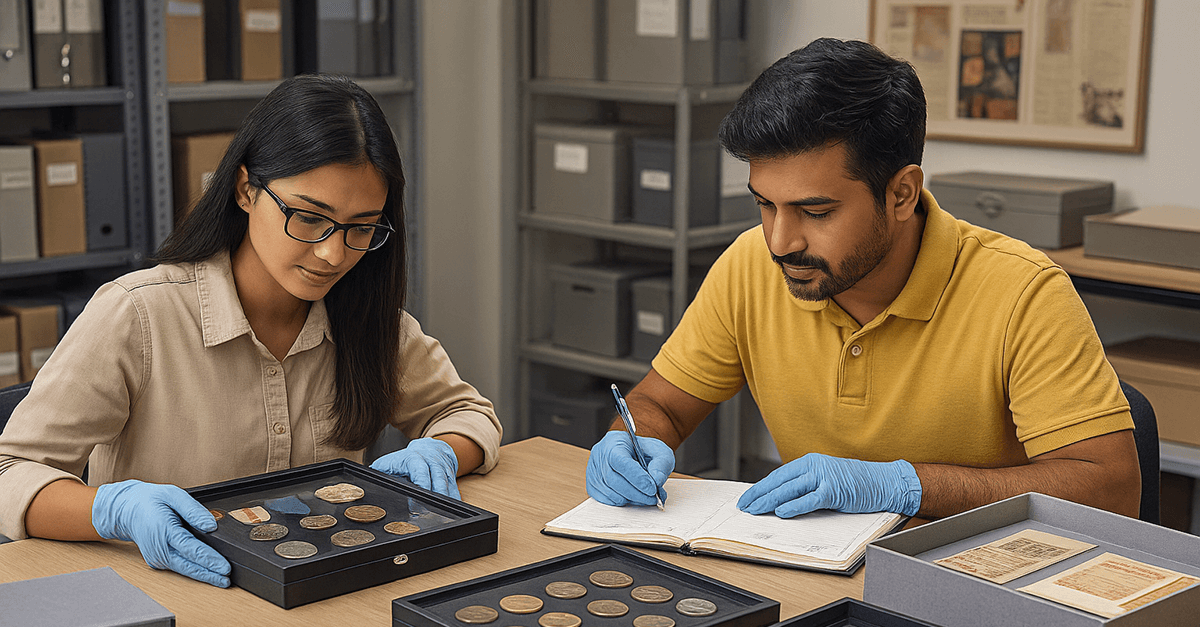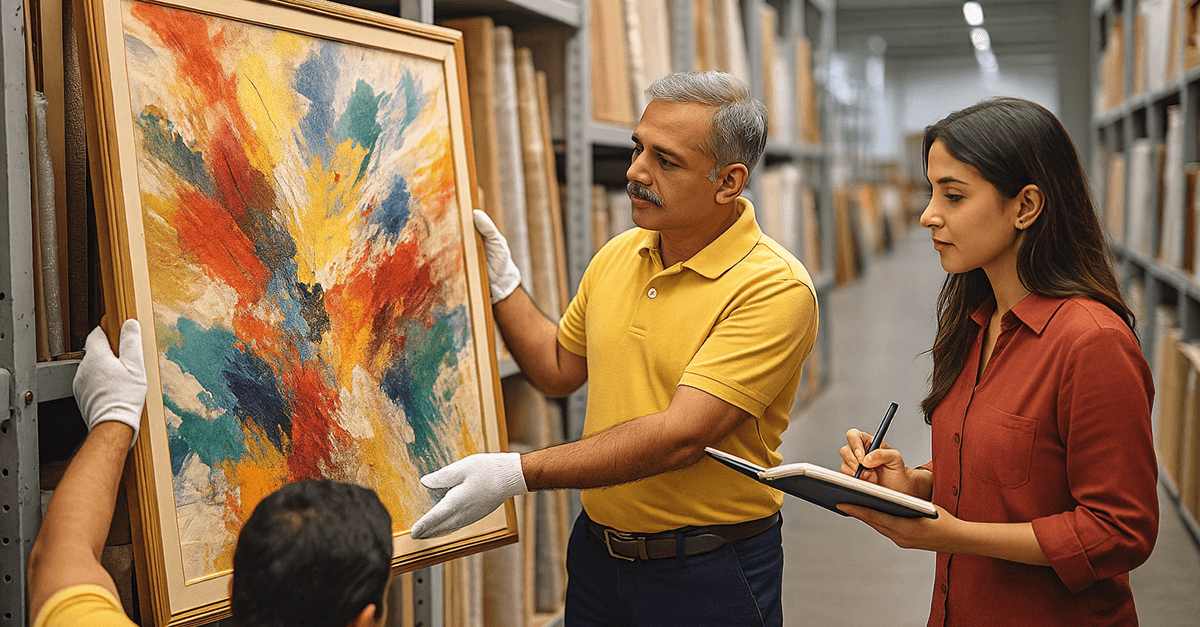Introduction: Why Digital Archiving is Transforming Art Care in India
For centuries, artworks existed only in the physical world — paintings, manuscripts, textiles, sculptures. Collectors cared for them through careful handling and occasional restoration. But today, the risks of environmental damage, theft, loss, and even natural disasters make it clear that physical preservation is not enough.
Enter digital archiving — the practice of creating secure, high-resolution digital records of artworks, enriched with metadata and stored for long-term access. Globally, museums and galleries have embraced this shift. In India, digital archiving is still emerging, but it is quickly becoming essential for private collectors, corporates, and institutions.
This blog explores the importance, tools, standards, and processes of digital archiving in India. By the end, you’ll understand why digitisation is not just a trend but the future of art care.
What is Digital Archiving of Art?
Digital archiving is the process of digitally recording and storing artworks in a structured, searchable, and secure format.
A proper digital archive includes:
- High-resolution images or scans of artworks
- Metadata: artist, title, medium, dimensions, provenance, condition
- Digital storage solutions: local drives, cloud servers, or hybrid systems
- Access platforms: searchable databases or apps for collectors and institutions
The goal is not to replace the physical artwork but to:
- Create a secure backup record
- Facilitate easier collection management
- Enable broader accessibility (for exhibitions, research, or valuation)
Why Digital Archiving Matters for Indian Collectors
1. Protection Against Climate Risks
India’s climate — humid monsoons, high heat, dust, and pollution — can cause irreversible damage. Digital archives ensure at least a permanent visual and documentary record even if the physical piece deteriorates.
2. Insurance & Valuation
Insurance companies increasingly require digital documentation of artworks for coverage and claims. Digital archives streamline valuation updates by maintaining consistent records.
3. Accessibility & Sharing
For corporates and institutions, digital archives make collections searchable and sharable internally and externally — without moving fragile artworks.
4. Legacy & Scholarship
Digital records preserve the cultural significance of collections for future generations, while also enabling academic research.
5. Disaster Recovery
In cases of fire, flooding, or theft, digital archives become the only surviving record of artworks — critical for recovery and restitution.
Tools & Technology for Digital Archiving
Digital archiving requires both hardware and software solutions.
Hardware: Capturing High-Quality Records
- Cameras: DSLR/mirrorless cameras with calibrated lighting for paintings and sculptures.
- Scanners: Flatbed or large-format scanners for works on paper.
- 3D Imaging Tools: For sculptures, artifacts, and textured surfaces.
Software: Managing and Storing Data
- Cataloging software: Custom art management systems with searchable fields.
- Digital asset management (DAM) tools: For corporates with large archives.
- Cloud storage: Google Cloud, AWS, or specialised art archiving platforms.
Emerging Technologies
- Blockchain for provenance: Immutable ownership history records.
- AI-powered image recognition: Automated tagging, condition monitoring.
- Augmented Reality (AR) & Virtual Reality (VR): Virtual exhibitions of archived works.
Global Standards for Digital Archiving
Professional digital archives follow museum-grade documentation standards.
- CDWA (Categories for the Description of Works of Art): Defines metadata fields for artworks.
- Dublin Core Metadata Standard: Widely used for cultural heritage digital assets.
- VRA Core: For visual resources, particularly photographs and design.
- IIIF (International Image Interoperability Framework): Ensures high-quality digital images can be shared across platforms.
For Indian collectors, adopting these standards ensures collections are globally credible and interoperable.
The Process of Digital Archiving: Step-by-Step
Step 1: Planning & Audit
- Assess the size and scope of the collection.
- Decide whether digitisation will cover all works or selected highlights.
- Define goals: insurance, scholarship, or public sharing.
Step 2: Photography & Scanning
- Capture each artwork in high resolution.
- Ensure consistent lighting and calibration for colour accuracy.
- For fragile works, use non-invasive scanning methods.
Step 3: Metadata Creation
- Record descriptive, technical, and provenance information.
- Use standardised templates to ensure consistency.
- Cross-check provenance against existing records.
Step 4: Storage & Backup
- Store files in archival-quality formats (TIFF, RAW).
- Maintain multiple backups: local + cloud.
- Ensure access protocols for authorised users.
Step 5: Access & Usage
- Build a searchable digital catalog.
- Provide tiered access (e.g., public vs private records).
- Enable integration with valuation, insurance, or exhibition planning.
Step 6: Maintenance & Updates
- Digital archives are not “one-and-done.”
- Update metadata and images whenever an artwork is restored, loaned, or revalued.
Challenges of Digital Archiving in India
1. Infrastructure Gaps
Not all collectors have access to museum-grade scanning equipment or secure storage servers.
2. Lack of Awareness
Many collectors undervalue digital documentation, assuming physical records are sufficient.
3. Cost Considerations
Professional archiving can seem expensive, though it is an investment in protection.
4. Data Security Risks
Collectors worry about digital data leaks or theft. Choosing secure, encrypted platforms is critical.
Solutions & Best Practices for Indian Collectors
- Start Small, Scale Gradually: Begin with digitising the most valuable works, then expand.
- Work with Professionals: Partner with conservators and archivists trained in digital archiving.
- Invest in Secure Storage: Use encrypted cloud storage and ensure multiple backups.
- Integrate Cataloging & Archiving: Don’t treat them separately — catalog entries should automatically link to digital archives.
- Consider Public Engagement: For corporates, digital archives can be adapted into public-facing platforms, enhancing brand value.
Case Examples in India
A Private Collector in Delhi
Digitised a collection of 300 artworks, integrating high-resolution images with provenance and valuation. The digital archive allowed smooth insurance renewal and simplified estate planning.
A Corporate House in Mumbai
Created a digital art archive for 150 works displayed across offices. The archive doubled as a cultural engagement tool, with employees accessing the digital catalog online.
A Heritage Institution in Kolkata
Digitised rare manuscripts and artworks to protect them from monsoon-related risks. The digital archive is now used by international researchers.
The Future of Digital Archiving in India
- Wider Adoption: As awareness grows, digital archiving will become standard among serious collectors.
- Integration with AI: Automated tagging, condition monitoring, and predictive conservation.
- Virtual Collections: Corporates and collectors may showcase collections through VR galleries.
- Cultural Preservation: National initiatives may digitise heritage collections, ensuring global accessibility.
Digital archiving is not just about safeguarding art. It’s about making collections future-ready in a digital-first world.
Conclusion: Digitisation as Cultural Stewardship
For Indian collectors, digital archiving bridges the gap between tradition and technology. It ensures that collections are not only protected against risks but also positioned for visibility, valuation, and legacy.
Art is timeless, but without proper documentation, it can be vulnerable. By embracing digital archiving, collectors ensure that their cultural treasures live on — securely preserved and accessible for generations to come.To explore how your collection can be digitised and future-proofed, discover our specialised Art Archiving Services. At TurmericEarth, we combine technical expertise, international standards, and cultural sensitivity to build archives that are secure, accurate, and globally relevant.








